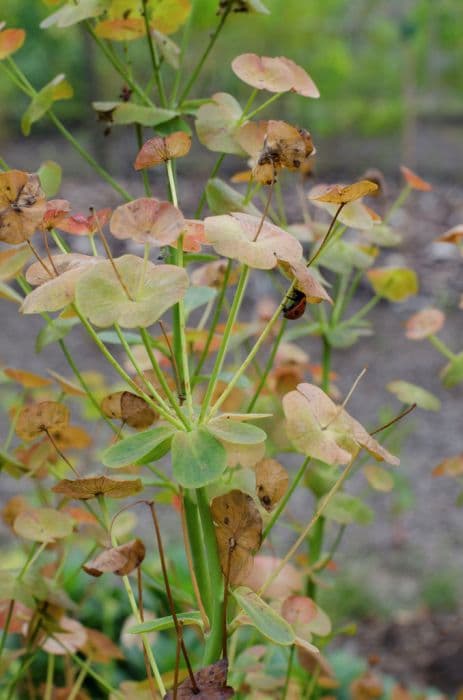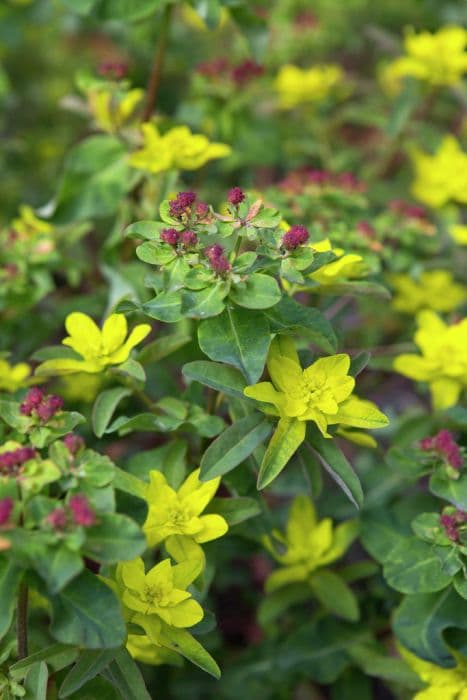Schilling's Spurge Euphorbia schillingii

ABOUT
Euphoria schillingii, known as Schilling's spurge, is a perennial plant characterized by its robust and structured appearance. Its leaves are typically arranged in a spiral fashion and are narrow with a pointed tip, looking somewhat lance-shaped. The foliage tends to have a rich green color which can add a luscious look to the plant's presence. Schilling's spurge produces flowers that are not showy in the traditional sense; instead, they have specialized structures called cyathia which give the blooms a unique and intriguing form. These floral structures usually consist of a cup-like shape with petal-like appendages that may be yellow or greenish-yellow, often attracting the eyes of garden enthusiasts. The plant's overall shape is upright with a branching habit that gives it a full appearance. The stems tend to be sturdy, and they often bear the leaves and flowers at their tips. This gives Schilling's spurge a somewhat top-heavy look, with the bulk of its visual interest occurring at the top of the plant's form. Moreover, the textural quality of Schilling's spurge contributes to its aesthetic, with the leaves and stems sometimes having a slightly waxy or leathery feel. This texture, combined with its form and color, makes it not only a green delight in gardens but also an interesting subject for textural contrast in mixed plantings. As a member of the spurge family, it is important to note that, like many of its relatives, this plant may exude a milky sap when cut or broken. This sap can be irritating to the skin and harmful if ingested, so care should be taken when handling Schilling's spurge.
About this plant
 Names
NamesFamily
Euphorbiaceae
Synonyms
Schilling's Spurge, Schilling Euphorbia
Common names
Euphorbia schillingii.
 Toxicity
ToxicityTo humans
Euphorbia schillingii, commonly known as Schilling's spurge, contains a milky sap called latex that is toxic to humans. The latex can cause skin irritation and inflammation when it comes into contact with the skin and can be even more harmful if ingested or if it comes into contact with the mucous membranes, such as the eyes or mouth. Symptoms of ingestion may include pain and swelling in the mouth and throat, nausea, vomiting, diarrhea, and abdominal pain. In severe cases, there can be more serious reactions such as difficulty swallowing, breathing difficulties, or systemic reactions. It is important to handle Schilling's spurge with care and to seek medical attention if accidental ingestion or sap exposure occurs.
To pets
Schilling's spurge is toxic to pets due to the milky latex it produces. When pets come into contact with this latex, it can cause symptoms similar to those in humans, including skin irritation, mouth and throat irritation if ingested, and gastrointestinal upset. Symptoms of poisoning in pets may include drooling, vomiting, diarrhea, pawing at the mouth, and in more severe cases, difficulty breathing or swallowing. If you suspect your pet has ingested any part of this plant or come into contact with its sap, it is important to consult with a veterinarian immediately.
 Characteristics
CharacteristicsLife cycle
Perennials
Foliage type
Evergreen
Color of leaves
Green
Flower color
Yellow
Height
2 feet (0.61 meters)
Spread
2 feet (0.61 meters)
Plant type
Shrub
Hardiness zones
6
Native area
Caucasus
Benefits
 General Benefits
General Benefits- Ornamental Appeal: Euphorbia schillingii is known for its striking foliage and architectural form, making it an attractive addition to gardens, landscapes, and as a container plant.
- Drought Tolerance: This plant is highly drought-resistant, making it an excellent choice for xeriscaping and low-water gardens.
- Easy Maintenance: It requires minimal care once established, which can be beneficial for gardeners looking for low-maintenance plants.
- Long Blooming Season: Euphorbia schillingii offers a long season of interest with its persistent flowers, providing garden aesthetics from spring to fall.
- Pest Resistance: The plant is generally resistant to pests, which reduces the need for chemical treatments and makes it eco-friendlier.
- Attracts Pollinators: Its flowers can attract beneficial insects like bees and butterflies, supporting local ecosystems.
- Deer Resistance: Euphorbia schillingii is not favored by deer, making it a good choice for areas where deer browsing is a problem.
- Soil Adaptability: It can thrive in a range of soil conditions, which is useful for gardeners dealing with difficult soil types.
- Seasonal Interest: Aside from its flowers, the plant provides seasonal interest through its evergreen leaves and colorful bracts in certain cultivars.
 Medical Properties
Medical PropertiesThis plant is not used for medical purposes.
 Air-purifying Qualities
Air-purifying QualitiesThis plant is not specifically known for air purifying qualities.
 Other Uses
Other Uses- Ornamental gardening: Euphorbia schillingii, commonly known as Schilling's spurge, is used as a striking ornamental plant in gardens and landscapes for its attractive foliage and unique structure.
- Erosion control: The plant can be used in areas susceptible to soil erosion, as its roots help to stabilize the soil.
- Low-maintenance groundcover: Schilling's spurge is drought-tolerant and can provide a ground covering in dry, rocky locations where other plants might struggle to survive.
- Dye production: Like many Euphorbia species, it may have potential for use in natural dye production, although specific uses in dyeing with Euphorbia schillingii are not well documented.
- Art and floral design: Its unique form and lasting structure make it suitable for use in dried floral arrangements and artistic installations.
- Educational tool: The plant can be used to educate people on xeriscaping and water-wise gardening practices, due to its low water requirements.
- Biological studies: Euphorbia schillingii can be used for studying plant adaptations to arid environments and for teaching plant physiology.
- Inter-plant relationships: It can be planted as part of a biodiversity garden to explore its relationship with other plants and insects, particularly pollinators that may be attracted to its flowers.
- Photography subject: With its striking appearance, Schilling's spurge is often a subject of interest for nature and macro photography.
- Cultural significance: In some cultures, Euphorbia species may hold symbolic meaning and be used in cultural ceremonies, though specific practices with Schilling's spurge are not commonly reported.
Interesting Facts
 Feng Shui
Feng ShuiThe plant Euphorbia schillingii is not used in Feng Shui practice.
 Zodiac Sign Compitability
Zodiac Sign CompitabilityThe plant Euphorbia schillingii is not used in astrology practice.
 Plant Symbolism
Plant Symbolism- Resilience: Euphorbia schillingii, commonly known as "Schilling's spurge," often thrives in challenging conditions, symbolizing our capability to endure and adapt to various hardships.
- Protection: Schilling's spurge has a sap that is toxic to many animals and can cause irritation to human skin, which is seen as a natural protective mechanism, representing the need for setting boundaries and safeguarding ourselves.
 Water
WaterThe Euphorbia schillingii, commonly known as the spurge, requires careful watering to avoid over-saturation. It should be watered once every 7 to 10 days during the growing season, allowing the soil to dry out completely between waterings. During winter, reduce watering to once every two weeks. When you water the spurge, provide enough water to soak the soil to a depth of about an inch, which often translates to approximately 8-16 ounces for a medium-sized pot, depending on soil composition and pot size. It's crucial to avoid letting the plant sit in water, as this can lead to root rot.
 Light
LightThe spurge thrives best in full sun to partial shade conditions. It should be placed in a spot where it can receive at least 3 to 4 hours of direct sunlight daily. A south-facing window is an ideal location for indoor spurges, while for outdoors, a spot that receives ample morning light and protection from the intense afternoon sun is suitable.
 Temperature
TemperatureThe spurge is adaptable to a range of temperatures but prefers being kept in an environment that's consistently between 50°F and 75°F. It can tolerate temperatures as low as 30°F but should be protected from frost. The plant can withstand high temperatures up to 90°F as long as it's not in direct midday sunlight, which can scorch the leaves.
 Pruning
PruningPruning the spurge helps maintain its shape and remove any damaged or diseased foliage. Light pruning can be done throughout the growing season as needed. However, the best time for significant pruning is early spring before new growth begins. Pruning is generally conducted once a year to encourage healthy new foliage.
 Cleaning
CleaningAs needed
 Soil
SoilThe best soil mix for Schilling's Spurge (Euphorbia schillingii) consists of a well-draining, gritty compost with a balance of peat, perlite or sand, and loam to encourage good root health. This species prefers a soil pH ranging from neutral to slightly acidic, ideally between 6.0 and 7.0.
 Repotting
RepottingSchilling's Spurge (Euphorbia schillingii) should be repotted every two to three years, or when it outgrows its current pot, to replenish nutrients in the soil and give roots room to grow.
 Humidity & Misting
Humidity & MistingSchilling's Spurge (Euphorbia schillingii) tolerates a range of humidity levels but prefers average to dry conditions, being careful not to provide overly humid environments that might promote rot.
 Suitable locations
Suitable locationsIndoor
Provide bright light, well-draining soil, and minimal watering.
Outdoor
Plant in full sun to partial shade with well-draining soil.
Hardiness zone
5-9 USDA
 Life cycle
Life cycleEuphorbia schillingii, commonly known as Schilling's Spurge, starts its life cycle as a seed that germinates in late spring when soil temperatures and moisture conditions are suitable. Following germination, the seedling emerges and establishes a small rosette of leaves during its first year, focusing on root development. In subsequent years, it develops a woody base and grows into a clumping perennial with upright stems and a more extensive root system. It reaches maturity in a few years, producing characteristic greenish-yellow flowers typically in late spring to early summer, and these are followed by the production of seeds contained within capsule-like fruits. Pollination is typically carried out by insects attracted to the inconspicuous flowers. The plant completes its lifecycle when these seeds are dispersed to the surrounding environment, enabling a new generation to begin the cycle again, with the mature plant possibly living for several years and flowering annually.
 Propogation
PropogationPropogation time
Spring to summer
Euphorbia schillingii, commonly known as Schilling's spurge, is most commonly propagated using cuttings. The best time to take cuttings for propagation is during the plant's active growth season, usually in the spring or early summer. To propagate, a healthy stem cutting about 3 to 5 inches (approximately 7.5 to 12.5 centimeters) long is taken with a clean, sharp pair of scissors or a knife. It's important to allow the cutting to dry for a few days to form a callus over the cut surface, which helps to prevent rot when planted. The callused cutting is then inserted into a well-draining soil mix, and kept warm and lightly moist until roots develop. During this rooting period, the cutting should be kept in a bright, indirect light environment to encourage growth without overwhelming the young plant. It can take several weeks for the cutting to establish a substantial root system.


![Spurge [Silver Swan]](/_next/image?url=https%3A%2F%2Fplants-admin.emdemapps.com%2Fimages%2Fplants%2F%2Fimages%2F604b573f6c8f6.png&w=640&q=75)






